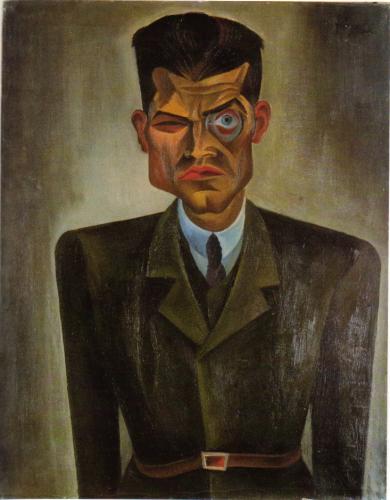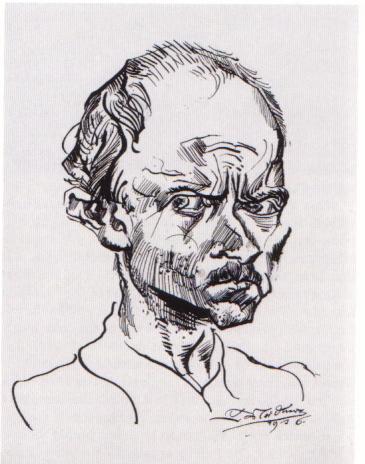-

Conrad Felixmüller ( 21 May 1897 - 24 March 1977 )
One of the youngst members of the "New Objectivity"
After attending drawing classes at the Dresden Kunstgewerbeschule [School of Applied Arts] for one year, Felixmüller enrolled in the private school of the artist Ferdinand Dorsch in 1912 and, in the same year, the class of Professor Carl Bantzer at the Königliche Akademie [Royal Academy] in Dresden, where he began his training as a painter. When Felixmüller left the Academy in 1915 he worked as an independent artist in Dresden, but also spent much of his time in Berlin, where he painted in Ludwig Meidner's studio. Here he also worked for Herwarth Walden's journal 'Der Sturm' as a graphic designer. Together with the book seller Felix Stiemer the artist founded the art and literature journal 'MENSCHEN' in 1917. He was responsible for the graphic design of this journal. He had exhibitions at Hans Goltz' gallery in Munich and, together with Heckel, Kirchner and Schmidt-Rottluff, at the Galerie Arnold in Dresden. Felixmüller moved to Dresden in 1918. He was a founding and board member of the 'Dresden Sezession' and a member of the 'November Gruppe'. At the same time he worked for various journals (such as 'Die Sichel', Regensburg; 'Rote Erde', Hamburg) and published his own texts, such as his autobiography 'Mein Werden' (Kunstblatt), or his thoughts about 'Künstlerische Gestaltung' [Artistic Design] (Kestnerbuch, Hannover). Felixmüller's early work is strongly influenced by Expressionism which he understood in a socio-critical context and transformed into his own expressive realism. The powerful lines of his woodcuts depict scenes of every-day life. There was a change around 1930, evident in increasingly genre-like, narrative subjects and a calmer pictorial language. 40 works by Felixmüller were included in the 1933 exhibition of 'Degenerate Art' in Dresden. The artist moved to Berlin-Charlottenburg in 1934, hoping that the working environment would be more liberal here. 151 of his works in public collections were confiscated in 1937. When his Berlin domicile was destroyed by a bomb in 1941 Felixmüller sought refuge in Damsdorf in the Mark. He moved to Tautenhain in 1944, but was called-up for military service in the same year. He returned to Tautenhain in 1945 after a brief period as a prisoner-of-war in Russia. He was appointed professor at the Martin-Luther-University in Halle in 1949, teaching drawing and painting in the faculty of education. Felixmüller returned to Berlin after his retirement in 1961. Numerous exhibitions have been dedicated to the artist between the end of the war and the artist's death in both parts of Germany as well as in Paris, Rome, Bologna and Florence.
-

ink on paper, (44x35cm)
-

Norma, opera in two acts by Vincenzo Bellini with libretto by Felice Romani after Norma, ossia L'infanticidio by Alexandre Soumet. First produced at La Scala on December 26, 1831. It is generally regarded as an example of the supreme height of the Bel canto tradition.
-
-

Amadeo de Souza Cardoso
At the age of 18 he entered the Superior School of Fine Arts of Lisbon, and two years later he leaves to Paris, where he intends to continue his studies but soon he quits the architecture course and starts to study painting. In Paris he became close with artists and writers like Gertrude Stein, Juan Gris, Max Jacob, Delaunay and Brancusi.He was also a friend of Amedeo Modigliani,who exposed sculptures in is Paris studio. He returned to Portugal during World War I where he married with Lúcia Peretto and maintained contact with other Portuguese artists and poets like Almada Negreiros, Santa-Rita Pintor and Teixeira de Pascoaes. He died of influenza October 25th 1918.
He worked In the first stage, under the Spanish painter Anglada Camarasa, his painting stile was close to naturalism and impressionism. Around 1910 he became one of the first modern Portuguese painters, influenced both by cubism as by futurism.His style is aggressive and vivid both in form and colour and the compositional structure of his works may seem random or chaotic at first sight but are clearly defined and balanced. His more innovative paintings, like "Trou de la Serrure" look like collages, and seems to pave the way to abstractionism or even dadaism in his painting. In 1913 he exhibited eight works at Armory Show in USA, some of them can be seen in American museums. As a gifted draughtsman his ink drawings, always figurative, for their decorative richness and oriental like style can be somehow related to those of Aubrey Beardsley. His work remained almost unknown after his death until 1952 when a room dedicated to his paintings in Amarante Museum gained the public's attention.
MMaxi on the move










